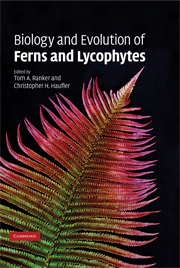Book contents
- Frontmatter
- Contents
- List of contributors
- Preface
- Acknowledgments
- Part I Development and morphogenesis
- Part II Genetics and reproduction
- 4 Population genetics
- 5 Antheridiogens
- 6 Structure and evolution of fern plastid genomes
- 7 Evolution of the nuclear genome of ferns and lycophytes
- Part III Ecology
- Part IV Systematics and evolutionary biology
- Index
- References
6 - Structure and evolution of fern plastid genomes
Published online by Cambridge University Press: 11 August 2009
- Frontmatter
- Contents
- List of contributors
- Preface
- Acknowledgments
- Part I Development and morphogenesis
- Part II Genetics and reproduction
- 4 Population genetics
- 5 Antheridiogens
- 6 Structure and evolution of fern plastid genomes
- 7 Evolution of the nuclear genome of ferns and lycophytes
- Part III Ecology
- Part IV Systematics and evolutionary biology
- Index
- References
Summary
Introduction
The concept of the genome, as the haploid complement of genes of an organism, is far from recent. The term genome is usually attributed to Hans Winkler in 1920 (Ledergerg and McCray, 2001). However, fine scale maps and understanding of the function of genes in the context of the genome did not begin until the 1970s after DNA sequencing techniques were developed. The term genome (and its corresponding genomics) can mean different things to different people (Ledergerg and McCray, 2001) but here we will focus on structural and evolutionary aspects of genomes in ferns. Although genomics is generally reserved for the main (nuclear) component of an organism, that topic is covered in Chapter 7. Instead we narrow the focus here to the chloroplast (i.e., plastid) genome. This small, well-defined genome is found in all green plants. Among land plants the plastid genome is highly conserved in structure and gene content (Palmer, 1985b). Compared to most nuclear genomes studied, plastid genomes contain a high proportion of DNA that codes for proteins and for RNA (ribosomal and transfer). Much of the non-coding regions (between protein-encoding genes) is transcribed and may well have important regulatory functions.
Because the plastid genome contains a high density of genes of well-studied processes, the genome is an excellent model for investigations into the relationship between genome structure and function. This field represents an ideal starting point leading into the much more complex field of the study of nuclear genomes.
- Type
- Chapter
- Information
- Biology and Evolution of Ferns and Lycophytes , pp. 159 - 174Publisher: Cambridge University PressPrint publication year: 2008
References
- 2
- Cited by



